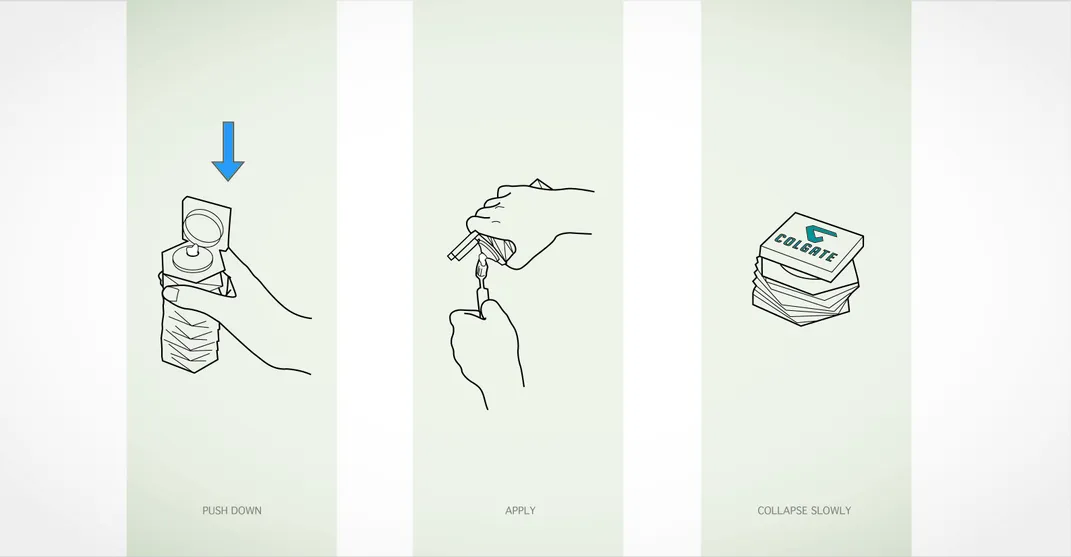A Toothpaste Tube That Gets Every Last Bit Out
Tired of wasting leftover toothpaste, a student invents a new origami-inspired design that leaves nothing behind
:focal(771x492:772x493)/https://tf-cmsv2-smithsonianmag-media.s3.amazonaws.com/filer/2f/59/2f59bb4f-fb68-42b0-bb7e-60f3d302e58d/origami_toothpaste.jpg)
We've all been there: The dreaded end of the toothpaste tube. Whether you've tried squeezing and flattening the container into a pulp—or spent far too long devising other methods to get every penny's worth—it doesn't take long to realize that what consumers are stuck with is a slightly less-than-perfect mechanism for delivering that last stubborn bit of toothpaste.
It's one of those universal predicaments people have just come to live with, mostly because the aluminum-based bottles work (for the most part) well enough. That's also likely why toothpaste containers haven't changed since early innovators Johnson & Johnson debuted their breakthrough collapsible tube design way back in 1898.
But Nicole Pannuzzo, a student at Arizona State University, started thinking a bit harder about this tiny flaw, and figured she could do the old toothpaste tube one better.
"Toothpaste is one product that is so classic, everybody uses, and that everyone has a small annoyance with," she says. "I thought it would be an interesting project to take on."
The third-year interior architecture major isn't the first to take a stab at a solution. A quick search on Google yields a compendium of wacky do-it-yourself workarounds, ranging from simply pressing the tube against the edge of the counter to cutting it up and scaping out the remains.
But her "Colgate Redesign" project, which began as a class assignment, goes after the design of the tube itself.
Pannuzzo says she felt the most practical approach to solving the problem was applying the principles of origami, the ancient art of Japanese art paper folding. Though long synonymous with paper cranes and other toy craftwork, the foldaway method has also been used by designers and engineers to improve the way existing technologies like airbags and space telescopes operate. The idea is that by strategically mapping out the way a foldable object collapses, developers can make objects more compact and reduce waste.

Pannuzzo experimented with about 100 prototypes of varying shapes and sizes before settling on a freestanding hexagonal-shaped cylinder that folds down easily like an accordion as toothpaste is squeezed out. Modeled after the BUILT origami wine tote, the tube's flat bottom allows the product to stay balanced as it gradually collapses down to a compact sheet. She also revamped the Colgate logo to give the exterior branding a distinct new look.

Pannuzzo, who previously had no experience with origami, says she has yet to put her invention through rigorous field testing (which also begs the question, how do you get toothpaste into the tube, anyway?). But she is already thinking of ways it can be improved.
"I saw this project as an act of experimentation because you never know unless you try," she addsed. "In no way do I see this as the best possible design solution, however it did open new possibilities to product design."
What's encouraging, though, is that word of Pannuzzo's has since made its way to Colgate and some of the company's higher-ups for consideration. It's not clear whether the brand will actually act on the product, but regardless, Pannuzzo says she's grateful for the all the attention her idea has received.
In the meantime, life hackers everywhere have little choice other than to continue weighing the costs versus the benefits in deciding when to hold on to those pesky convential tubes—and when to fold them away for good.
/https://tf-cmsv2-smithsonianmag-media.s3.amazonaws.com/accounts/headshot/tuan-nguyen.jpg)
/https://tf-cmsv2-smithsonianmag-media.s3.amazonaws.com/accounts/headshot/tuan-nguyen.jpg)